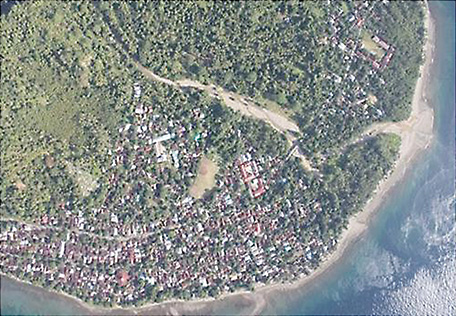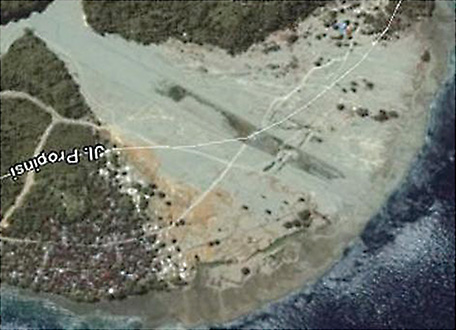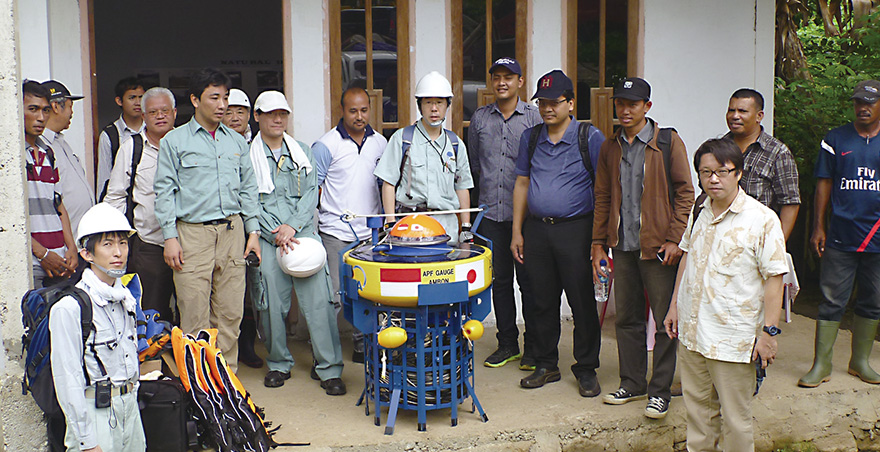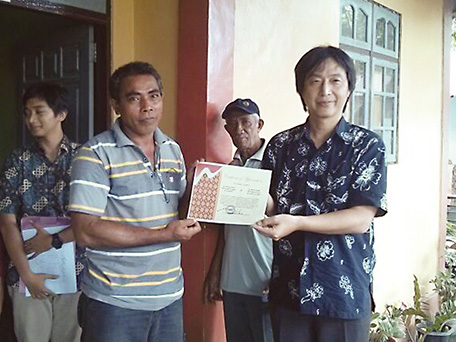Stories from the field 06
How the disaster management technology of Japan, a disaster-prone nation, saved 5,000 villagers from flooding
– Japanese engineers struggle against natural dam collapsing in Indonesia


A natural dam created in the upper stream of the Way Ela River. Before (above) and after (below) the collapse of the dam. (Photo: Ministry of Public Works of Indonesia)
Torrential rains continuing on from the previous day caused a natural dam to collapse, and a flood of debris rushed down the river and slammed relentlessly into the village. It was July 25, 2013, when intense torrential rain upstream of the Way Ela River, running through the central part of Negeri Lima village in Maluku Province of Indonesia, caused a natural dam to burst, which let out huge amount of water and debris. This debris flood rushed downstream to the village, home to approximately 5,000 people. Around 13 million cubic kilometers of water, equivalent to the amount of water in 5,200 Olympic-size swimming pools, flowed through the area. 30 hectares – equivalent to half of the village – was affected, causing damage to 422 households, schools, and other buildings. Regrettably, three people lost their lives in this disaster. However, there could have been thousands of casualties rather than just three.
It is not widely known that Japanese disaster risk reduction experts contributed greatly to minimizing flood damage. Mr. Hisaya Sawano, then an expert at JICA as a policy adviser on Integrated Water Resources Management for the Ministry of Public Works of Indonesia now working for Public Works Research Institute (PWRI),1 explained, “A natural dam forms when accumulated dirt caused by a large landslide due to an earthquake or torrential rain blocks water flow of a river. In this case, the dam that collapsed was formed by a massive landslide that occurred upstream of the Way Ela River in July 2012, a year before the flood. Right after that landslide, the Indonesian Ministry of Public Works asked for my advice on the assessment of the situation and possible countermeasures. So the first thing I did was visit the area to examine the situation, and then proposed the necessary emergency response measures. I also advised them that it was necessary to immediately summon an erosion and sediment control (“SABO” in Japanese) expert team from Japan to the site.”
In September 2012, a survey team from Japan conducted an intensive survey of the affected area. “From my experience of having seen many cases of natural dams in Japan, I immediately realized that we were dealing with quite a dangerous situation.” Mr. Tadanori Ishizuka of PWRI, who served as the survey team's SABO expert stated. Having concluded that the risk of collapse was extremely high, the survey team recommended that the Indonesian Ministry of Public Works immediately consider taking necessary countermeasures and preparedness efforts. In order to help the Ministry understand the danger of the situation, the team provided a video created in Japan that used computer-generated imagery (CGI) to illustrate what would happen if a natural dam collapsed. The video later proved to be more effective than the team expected.
Mr. Yoshio Tokunaga (PWRI), then an expert at JICA, who served as the Disaster Management Policy Adviser to National Disaster Management Agency (BNPB), visited the site many times and, together with the Chief of Negeri Lima Village, visited the disaster management offices in Maluku Province and Central Maluku Regency to urge them to strengthen countermeasures. In collaboration with the Embassy of Japan and local JICA Office, he also worked on grass-roots education with a local NGO for proper evacuations.
“During the early stages of our activities, there were residents and people concerned on the Indonesian side who did not believe that the natural dam would ever collapse because it was surrounded by sturdy-looking rocks. We therefore used the CGI video of the natural dam collapsing, which Mr. Ishizuka brought from Japan, along with erosion control pamphlets and other materials made by JICA, and continued the educational activities together with local and national NGOs, college students, and representatives of the village. The video was very effective. It helped a lot of the residents understand the danger of the natural dam collapse and the necessity of emergency evacuations,” Mr. Tokunaga commented.
At the end of February 2013 – five months prior to the natural dam collapse – PWRI, which Mr. Ishizuka belongs to, signed an agreement with the Ministry of Public Works of Indonesia, and then set up a device (PWRI's water stage gauging buoy) in order to automatically measure the water level of the natural dam. Relevant parties from Japan and Indonesia continued to monitor the natural dam, and shared information on its water level. The experts monitoring changes in the water level found that the situation had become dangerous several days before the collapse, and urged the village residents to evacuate. The residents, with clear images of possible damage from natural dam collapse, promptly evacuated, which contributed to minimizing casualties.
“On that day, I noticed on my computer in Japan that the water level of the natural dam had reached its full capacity and realized how terrible the situation became. I was very worried because I could not reach my collaborators in Indonesia by phone. It was a great relief when I later learned that the disaster had caused minimal casualties,” said Mr. Ishizuka. It can be said that this was achieved because the Indonesian government officials and local residents listened to the scientific analysis from Japan, a disaster prone nation. While this did not attract much attention in Indonesia because of the minimal damage, it is said that among local residents, many share a strong feeling that their lives were saved by Japanese.
“The natural conditions of Indonesia are similar in many ways to those of Japan, so I believe that Japan can greatly contribute to the field of water-related disasters in Indonesia,” commented Mr. Sawano. It is expected that Indonesia will take advantage of this experience when working to reduce the risks of possible disasters in the future.
*1 An Incorporated Administrative Agency

Experts, Mr. Tadanori Ishizuka (center) and Mr. Hisaya Sawano (right), in front of the PWRI's water stage gauging buoy. (Photo: Public Works Research Institute)

An expert, Mr. Yoshio Tokunaga (right), receiving a letter of appreciation from the village mayor to JICA. (Photo: Public Works Research Institute)
<< Previous Page Next Page >>
Main Text | Statictics and Reference Materials | Stories from the field | Master Techniques, From Japan to the World - | ODA Topics
